JEEP GRAND CHEROKEE 2021 Owner handbook (in English)
Manufacturer: JEEP, Model Year: 2021, Model line: GRAND CHEROKEE, Model: JEEP GRAND CHEROKEE 2021Pages: 378, PDF Size: 6.88 MB
Page 131 of 378
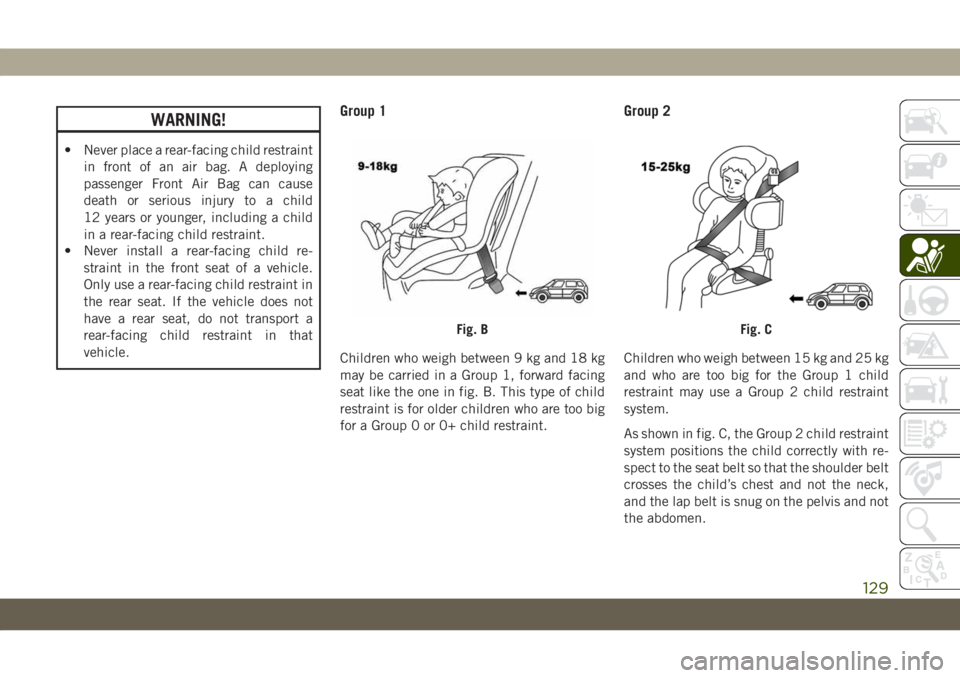
WARNING!
• Never place a rear-facing child restraint
in front of an air bag. A deploying
passenger Front Air Bag can cause
death or serious injury to a child
12 years or younger, including a child
in a rear-facing child restraint.
• Never install a rear-facing child re-
straint in the front seat of a vehicle.
Only use a rear-facing child restraint in
the rear seat. If the vehicle does not
have a rear seat, do not transport a
rear-facing child restraint in that
vehicle.
Group 1
Children who weigh between 9 kg and 18 kg
may be carried in a Group 1, forward facing
seat like the one in fig. B. This type of child
restraint is for older children who are too big
for a Group 0 or 0+ child restraint.
Group 2
Children who weigh between 15 kg and 25 kg
and who are too big for the Group 1 child
restraint may use a Group 2 child restraint
system.
As shown in fig. C, the Group 2 child restraint
system positions the child correctly with re-
spect to the seat belt so that the shoulder belt
crosses the child’s chest and not the neck,
and the lap belt is snug on the pelvis and not
the abdomen.
Fig. BFig. C
129
Page 132 of 378
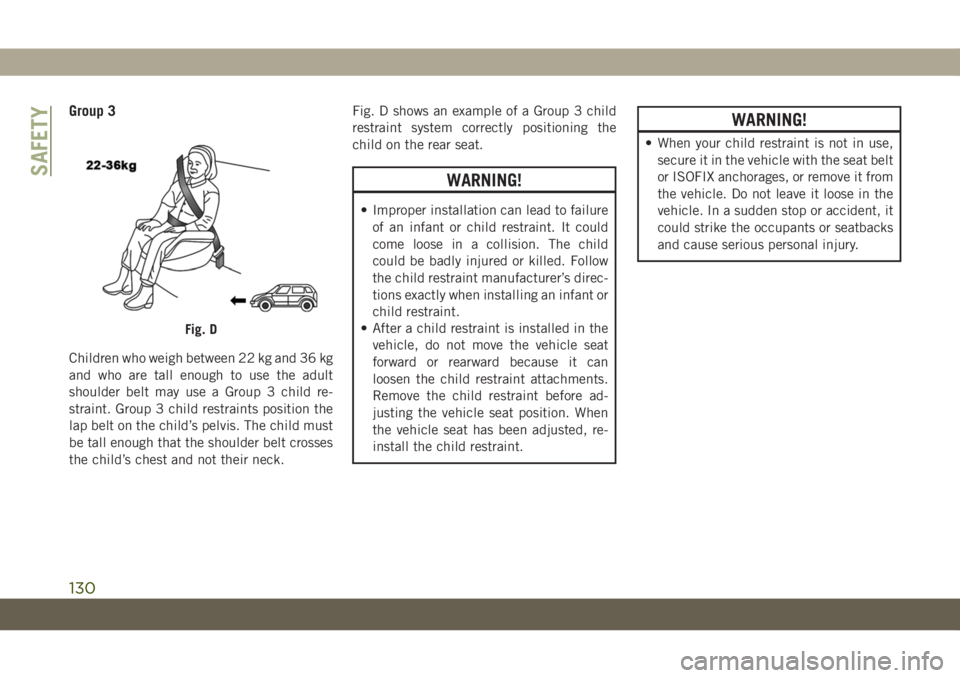
Group 3
Children who weigh between 22 kg and 36 kg
and who are tall enough to use the adult
shoulder belt may use a Group 3 child re-
straint. Group 3 child restraints position the
lap belt on the child’s pelvis. The child must
be tall enough that the shoulder belt crosses
the child’s chest and not their neck.Fig. D shows an example of a Group 3 child
restraint system correctly positioning the
child on the rear seat.
WARNING!
• Improper installation can lead to failure
of an infant or child restraint. It could
come loose in a collision. The child
could be badly injured or killed. Follow
the child restraint manufacturer’s direc-
tions exactly when installing an infant or
child restraint.
• After a child restraint is installed in the
vehicle, do not move the vehicle seat
forward or rearward because it can
loosen the child restraint attachments.
Remove the child restraint before ad-
justing the vehicle seat position. When
the vehicle seat has been adjusted, re-
install the child restraint.
WARNING!
• When your child restraint is not in use,
secure it in the vehicle with the seat belt
or ISOFIX anchorages, or remove it from
the vehicle. Do not leave it loose in the
vehicle. In a sudden stop or accident, it
could strike the occupants or seatbacks
and cause serious personal injury.
Fig. D
SAFETY
130
Page 133 of 378
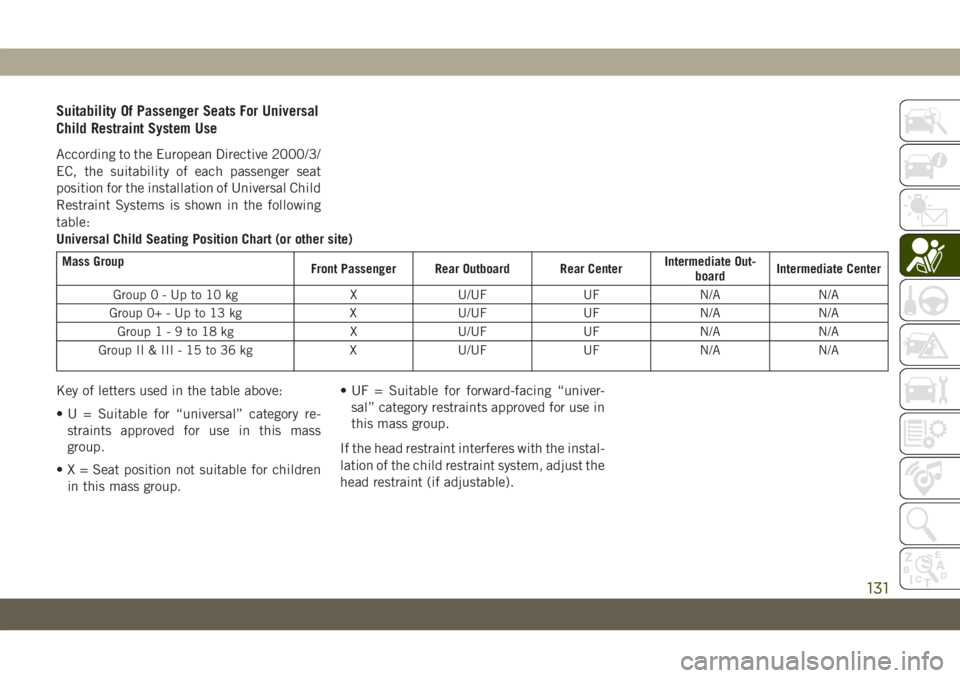
Suitability Of Passenger Seats For Universal
Child Restraint System Use
According to the European Directive 2000/3/
EC, the suitability of each passenger seat
position for the installation of Universal Child
Restraint Systems is shown in the following
table:
Universal Child Seating Position Chart (or other site)
Mass Group
Front Passenger Rear Outboard Rear CenterIntermediate Out-
boardIntermediate Center
Group0-Upto10kg XU/UF UF N/A N/A
Group 0+ - Up to 13 kg X U/UF UF N/A N/A
Group1-9to18kg XU/UF UF N/A N/A
Group II & III - 15 to 36 kg X U/UF UF N/A N/A
Key of letters used in the table above:
• U = Suitable for “universal” category re-
straints approved for use in this mass
group.
• X = Seat position not suitable for children
in this mass group.• UF = Suitable for forward-facing “univer-
sal” category restraints approved for use in
this mass group.
If the head restraint interferes with the instal-
lation of the child restraint system, adjust the
head restraint (if adjustable).
131
Page 134 of 378
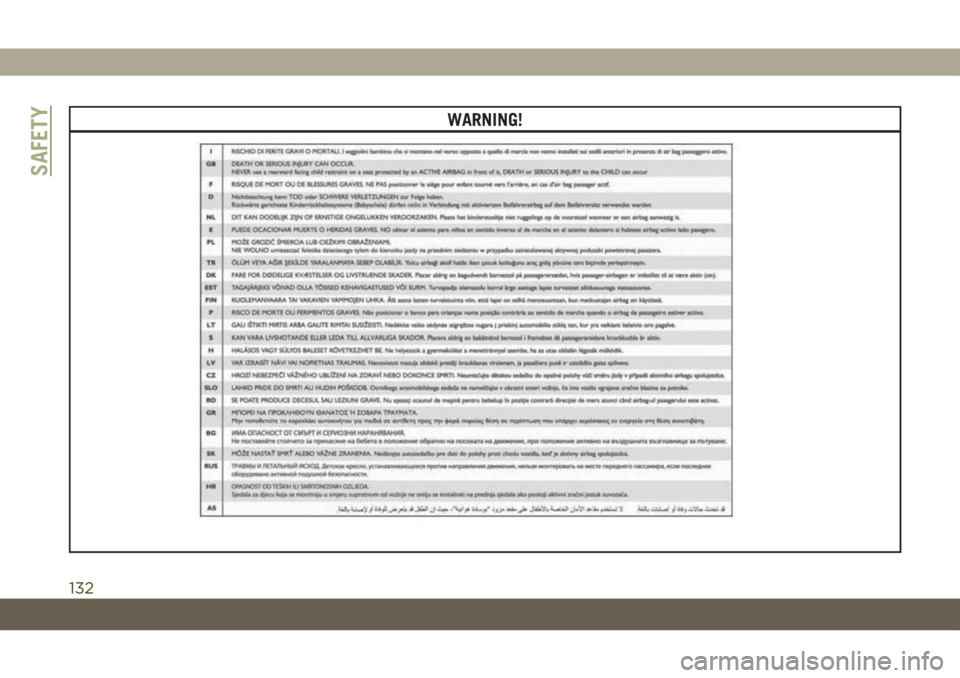
WARNING!
SAFETY
132
Page 135 of 378
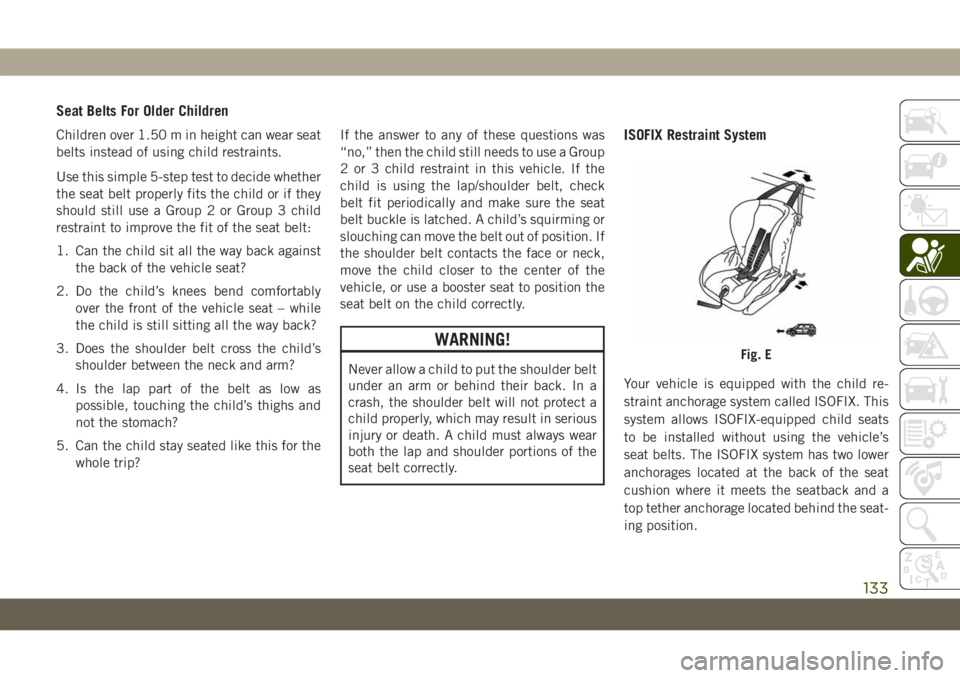
Seat Belts For Older Children
Children over 1.50 m in height can wear seat
belts instead of using child restraints.
Use this simple 5-step test to decide whether
the seat belt properly fits the child or if they
should still use a Group 2 or Group 3 child
restraint to improve the fit of the seat belt:
1. Can the child sit all the way back against
the back of the vehicle seat?
2. Do the child’s knees bend comfortably
over the front of the vehicle seat – while
the child is still sitting all the way back?
3. Does the shoulder belt cross the child’s
shoulder between the neck and arm?
4. Is the lap part of the belt as low as
possible, touching the child’s thighs and
not the stomach?
5. Can the child stay seated like this for the
whole trip?If the answer to any of these questions was
“no,” then the child still needs to use a Group
2 or 3 child restraint in this vehicle. If the
child is using the lap/shoulder belt, check
belt fit periodically and make sure the seat
belt buckle is latched. A child’s squirming or
slouching can move the belt out of position. If
the shoulder belt contacts the face or neck,
move the child closer to the center of the
vehicle, or use a booster seat to position the
seat belt on the child correctly.
WARNING!
Never allow a child to put the shoulder belt
under an arm or behind their back. In a
crash, the shoulder belt will not protect a
child properly, which may result in serious
injury or death. A child must always wear
both the lap and shoulder portions of the
seat belt correctly.
ISOFIX Restraint System
Your vehicle is equipped with the child re-
straint anchorage system called ISOFIX. This
system allows ISOFIX-equipped child seats
to be installed without using the vehicle’s
seat belts. The ISOFIX system has two lower
anchorages located at the back of the seat
cushion where it meets the seatback and a
top tether anchorage located behind the seat-
ing position.
Fig. E
133
Page 136 of 378
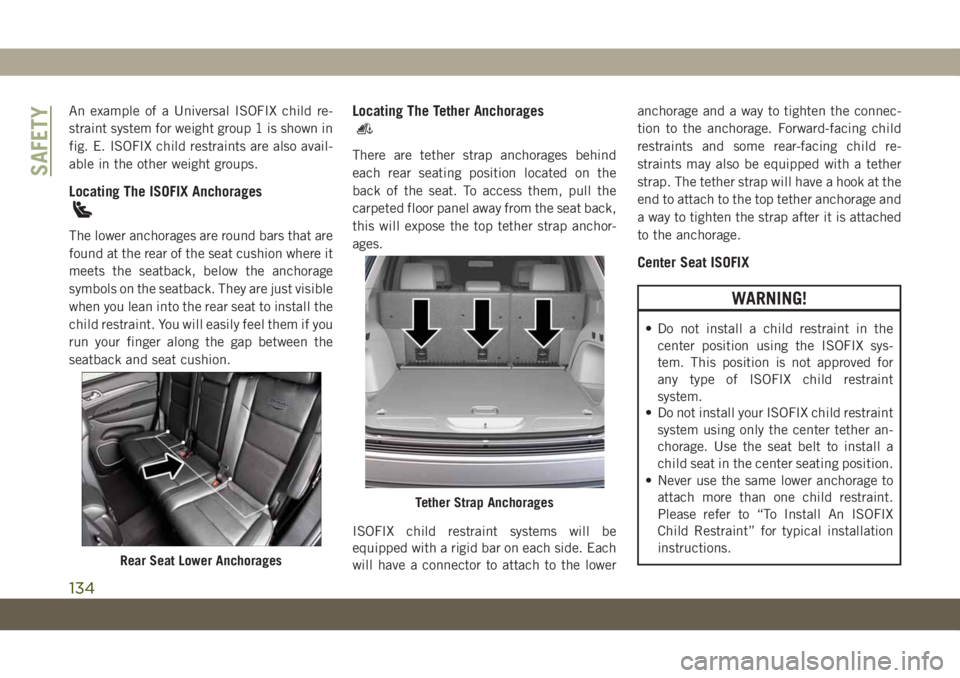
An example of a Universal ISOFIX child re-
straint system for weight group 1 is shown in
fig. E. ISOFIX child restraints are also avail-
able in the other weight groups.
Locating The ISOFIX Anchorages
The lower anchorages are round bars that are
found at the rear of the seat cushion where it
meets the seatback, below the anchorage
symbols on the seatback. They are just visible
when you lean into the rear seat to install the
child restraint. You will easily feel them if you
run your finger along the gap between the
seatback and seat cushion.
Locating The Tether Anchorages
There are tether strap anchorages behind
each rear seating position located on the
back of the seat. To access them, pull the
carpeted floor panel away from the seat back,
this will expose the top tether strap anchor-
ages.
ISOFIX child restraint systems will be
equipped with a rigid bar on each side. Each
will have a connector to attach to the loweranchorage and a way to tighten the connec-
tion to the anchorage. Forward-facing child
restraints and some rear-facing child re-
straints may also be equipped with a tether
strap. The tether strap will have a hook at the
end to attach to the top tether anchorage and
a way to tighten the strap after it is attached
to the anchorage.
Center Seat ISOFIX
WARNING!
• Do not install a child restraint in the
center position using the ISOFIX sys-
tem. This position is not approved for
any type of ISOFIX child restraint
system.
• Do not install your ISOFIX child restraint
system using only the center tether an-
chorage. Use the seat belt to install a
child seat in the center seating position.
• Never use the same lower anchorage to
attach more than one child restraint.
Please refer to “To Install An ISOFIX
Child Restraint” for typical installation
instructions.
Rear Seat Lower Anchorages
Tether Strap Anchorages
SAFETY
134
Page 137 of 378
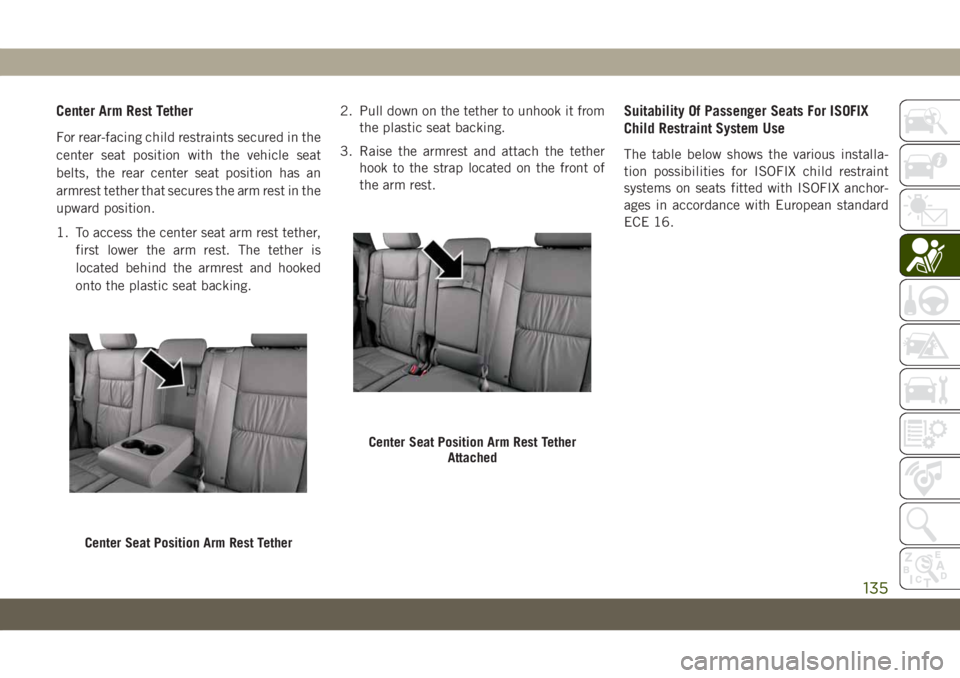
Center Arm Rest Tether
For rear-facing child restraints secured in the
center seat position with the vehicle seat
belts, the rear center seat position has an
armrest tether that secures the arm rest in the
upward position.
1. To access the center seat arm rest tether,
first lower the arm rest. The tether is
located behind the armrest and hooked
onto the plastic seat backing.2. Pull down on the tether to unhook it from
the plastic seat backing.
3. Raise the armrest and attach the tether
hook to the strap located on the front of
the arm rest.
Suitability Of Passenger Seats For ISOFIX
Child Restraint System Use
The table below shows the various installa-
tion possibilities for ISOFIX child restraint
systems on seats fitted with ISOFIX anchor-
ages in accordance with European standard
ECE 16.
Center Seat Position Arm Rest Tether
Center Seat Position Arm Rest Tether
Attached
135
Page 138 of 378
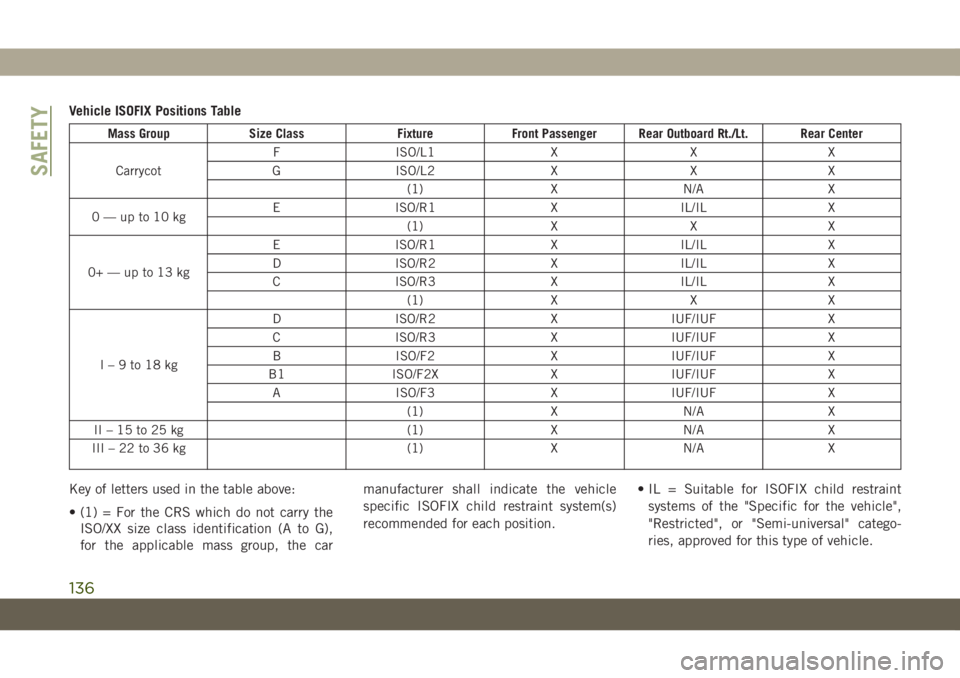
Vehicle ISOFIX Positions Table
Mass Group Size Class Fixture Front Passenger Rear Outboard Rt./Lt. Rear Center
CarrycotF ISO/L1 X X X
G ISO/L2 X X X
(1) X N/A X
0—upto10kgE ISO/R1 X IL/IL X
(1) X X X
0+—upto13kgE ISO/R1 X IL/IL X
D ISO/R2 X IL/IL X
C ISO/R3 X IL/IL X
(1) X X X
I–9to18kgD ISO/R2 X IUF/IUF X
C ISO/R3 X IUF/IUF X
B ISO/F2 X IUF/IUF X
B1 ISO/F2X X IUF/IUF X
A ISO/F3 X IUF/IUF X
(1) X N/A X
II–15to25kg (1) X N/A X
III – 22 to 36 kg (1) X N/A X
Key of letters used in the table above:
• (1) = For the CRS which do not carry the
ISO/XX size class identification (A to G),
for the applicable mass group, the carmanufacturer shall indicate the vehicle
specific ISOFIX child restraint system(s)
recommended for each position.• IL = Suitable for ISOFIX child restraint
systems of the "Specific for the vehicle",
"Restricted", or "Semi-universal" catego-
ries, approved for this type of vehicle.
SAFETY
136
Page 139 of 378
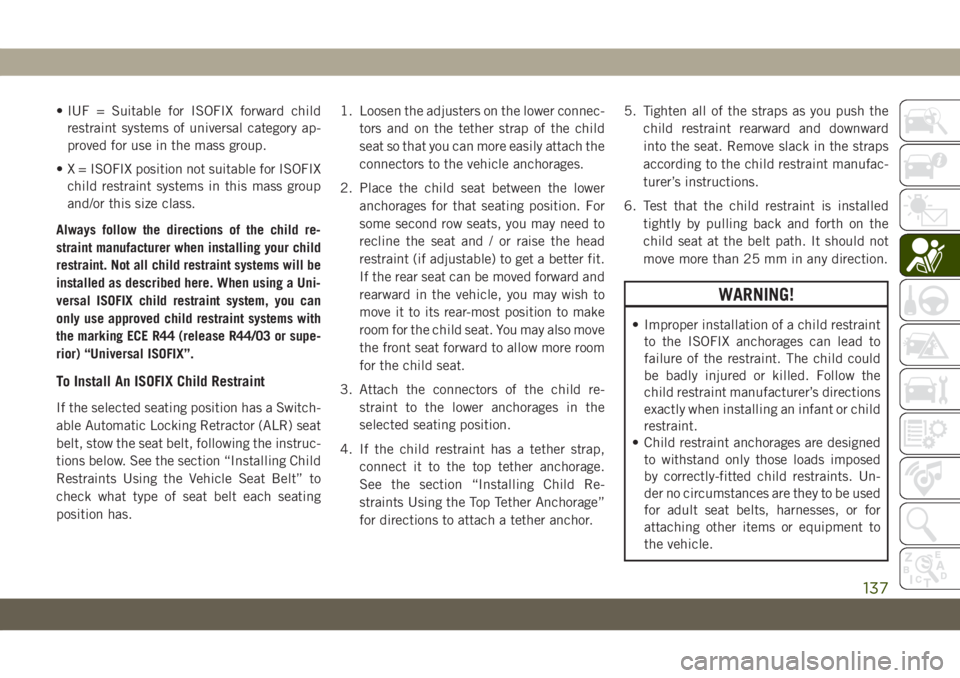
• IUF = Suitable for ISOFIX forward child
restraint systems of universal category ap-
proved for use in the mass group.
• X = ISOFIX position not suitable for ISOFIX
child restraint systems in this mass group
and/or this size class.
Always follow the directions of the child re-
straint manufacturer when installing your child
restraint. Not all child restraint systems will be
installed as described here. When using a Uni-
versal ISOFIX child restraint system, you can
only use approved child restraint systems with
the marking ECE R44 (release R44/03 or supe-
rior) “Universal ISOFIX”.
To Install An ISOFIX Child Restraint
If the selected seating position has a Switch-
able Automatic Locking Retractor (ALR) seat
belt, stow the seat belt, following the instruc-
tions below. See the section “Installing Child
Restraints Using the Vehicle Seat Belt” to
check what type of seat belt each seating
position has.1. Loosen the adjusters on the lower connec-
tors and on the tether strap of the child
seat so that you can more easily attach the
connectors to the vehicle anchorages.
2. Place the child seat between the lower
anchorages for that seating position. For
some second row seats, you may need to
recline the seat and / or raise the head
restraint (if adjustable) to get a better fit.
If the rear seat can be moved forward and
rearward in the vehicle, you may wish to
move it to its rear-most position to make
room for the child seat. You may also move
the front seat forward to allow more room
for the child seat.
3. Attach the connectors of the child re-
straint to the lower anchorages in the
selected seating position.
4. If the child restraint has a tether strap,
connect it to the top tether anchorage.
See the section “Installing Child Re-
straints Using the Top Tether Anchorage”
for directions to attach a tether anchor.5. Tighten all of the straps as you push the
child restraint rearward and downward
into the seat. Remove slack in the straps
according to the child restraint manufac-
turer’s instructions.
6. Test that the child restraint is installed
tightly by pulling back and forth on the
child seat at the belt path. It should not
move more than 25 mm in any direction.
WARNING!
• Improper installation of a child restraint
to the ISOFIX anchorages can lead to
failure of the restraint. The child could
be badly injured or killed. Follow the
child restraint manufacturer’s directions
exactly when installing an infant or child
restraint.
• Child restraint anchorages are designed
to withstand only those loads imposed
by correctly-fitted child restraints. Un-
der no circumstances are they to be used
for adult seat belts, harnesses, or for
attaching other items or equipment to
the vehicle.
137
Page 140 of 378
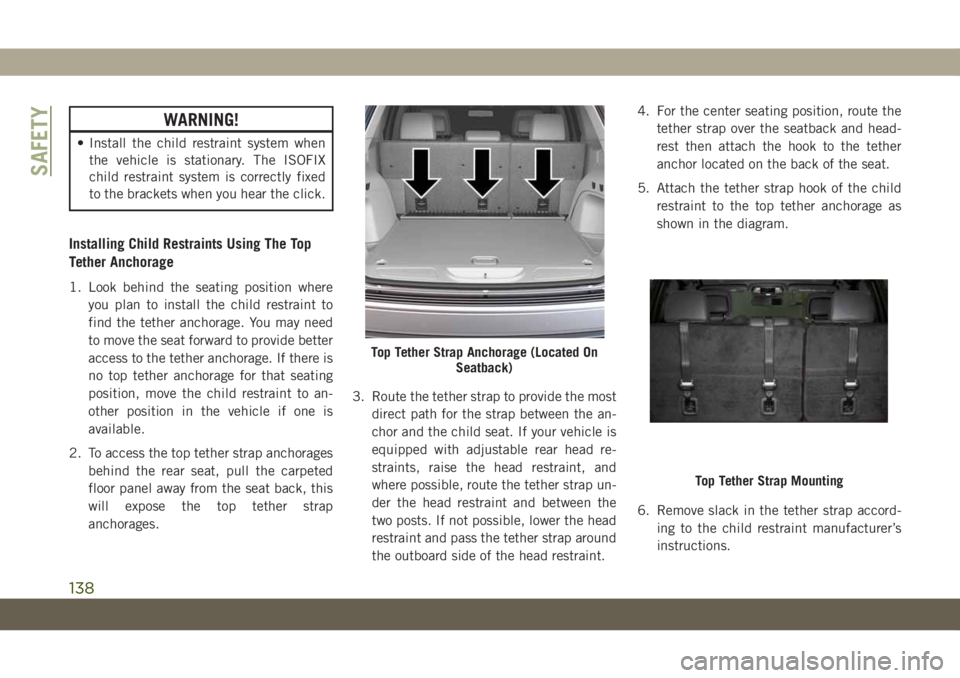
WARNING!
• Install the child restraint system when
the vehicle is stationary. The ISOFIX
child restraint system is correctly fixed
to the brackets when you hear the click.
Installing Child Restraints Using The Top
Tether Anchorage
1. Look behind the seating position where
you plan to install the child restraint to
find the tether anchorage. You may need
to move the seat forward to provide better
access to the tether anchorage. If there is
no top tether anchorage for that seating
position, move the child restraint to an-
other position in the vehicle if one is
available.
2. To access the top tether strap anchorages
behind the rear seat, pull the carpeted
floor panel away from the seat back, this
will expose the top tether strap
anchorages.3. Route the tether strap to provide the most
direct path for the strap between the an-
chor and the child seat. If your vehicle is
equipped with adjustable rear head re-
straints, raise the head restraint, and
where possible, route the tether strap un-
der the head restraint and between the
two posts. If not possible, lower the head
restraint and pass the tether strap around
the outboard side of the head restraint.4. For the center seating position, route the
tether strap over the seatback and head-
rest then attach the hook to the tether
anchor located on the back of the seat.
5. Attach the tether strap hook of the child
restraint to the top tether anchorage as
shown in the diagram.
6. Remove slack in the tether strap accord-
ing to the child restraint manufacturer’s
instructions.
Top Tether Strap Anchorage (Located On
Seatback)
Top Tether Strap Mounting
SAFETY
138